Artists
Ivana Bašić’s Newest Sculpture Is an Astounding Feat. It Took Her Six Years to Make
The New York-based artist wants to push materials to their limits.
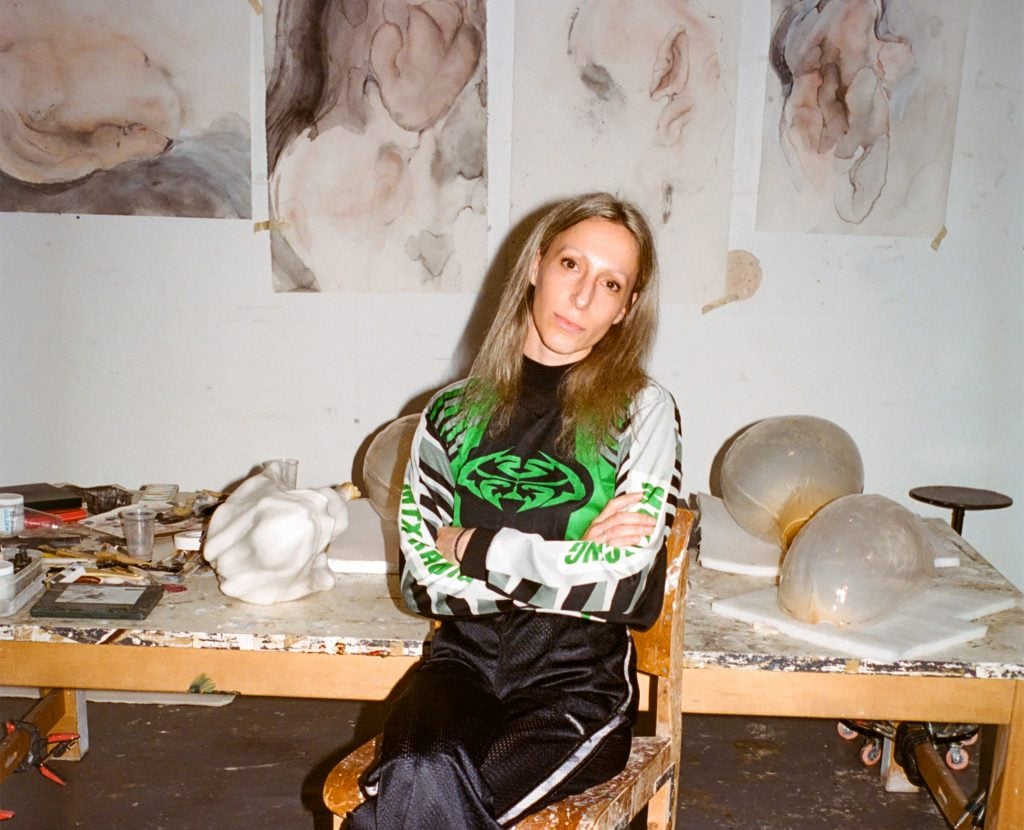
The New York-based artist wants to push materials to their limits.

Kate Brown

Belgrade-born, New York-based artist Ivana Bašić has a sculpture in Berlin that seems to be breathing. Technically, it is. Taking up a large portion of the top floor at Schinkel Pavillon in Berlin, an octagonally-shaped and exquisitely ornate space, the kinetic sculpture sighs and heaves in a pattern that is timed to the artist’s own breath. As it inhales and exhales, the sculpture’s pneumatic hammers pound down on a centerpiece of the work, an alabaster stone piece, that disintegrates bit by bit, under pressure. When I was in the gallery, soft white dust was gently falling to the marble floor. This metaphoric heart will be whittled away by the time the show closes in September.
The gut-punching melancholy that “Metempsychosis: The Passion of Pneumatics” evokes is a hard feeling to shake off, and it pervades her works and is what makes Bašić a fascinating creative force. Set against cold metals and machine-like shapes, the body and the spirit seem to be in a dangerous, at times violent dance with the facets of industrialization and automation. With astounding material ambition and an unbridled sense of scale, she is a bit of an alchemist in her studio, pushing materials she wields to their limits; brass and steel are juxtaposed with delicate glass or soft stones or wax to an eerie effect that is alien but deeply human. Bodies lurk in the curves of her sensual watercolor drawings, and organ-like shapes emerge from contorting feminine figures.
In a time of high churn, quick-hit art and click-to-buy consumerism, Bašić’s highly technical ways of working and dedication to time-intensive processes make her a remarkable artist to watch. Though her processes and the outcomes feel futuristic, there is something old world about her choice to carve away natural material to reveal new forms.
Recently, we caught up with Basic and asked her about her studio process, and about the work on view at Schinkel, which is the culmination of six years of work.
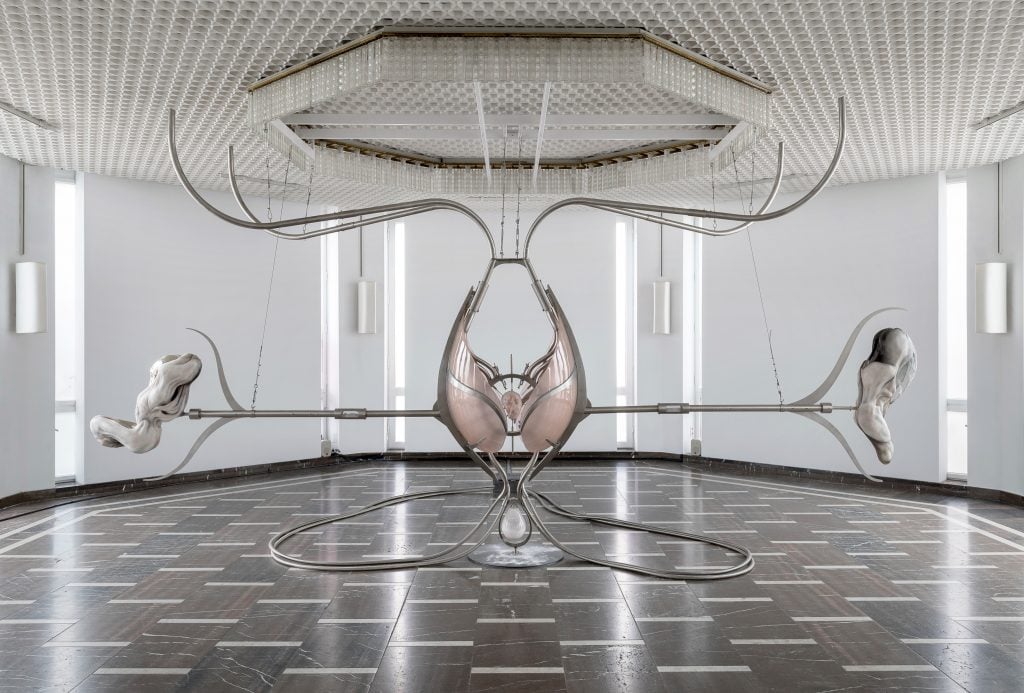
Installation view of “Metempsychosis: The Passion of Pneumatics” (2024), Schinkel Pavillon, Berlin; The exhibition is made possible with the support of Albion Jeune, Balkan Projects, and Francesca Minini. Photograph by Stefan Korte.
At your new show at Schinkel Pavillon, there is large-scale kinetic and pneumatic work that is the centerpiece. This strikes me as one of your most ambitious works yet. Can you walk us through the intentions of this work?
This piece is by far my most ambitious and complex piece to date. The work in the show has been in production for six years—and this piece in particular for four years. The sculpture functions as an altarpiece, inspired by Italian 17th-century depictions of the Immaculate Heart of Mary. In my sculpture, the traditional red heart is substituted by an alabaster stone, while the sun-like rays of the Immaculate Heart are replaced with pneumatic hammers that gradually pound the stone to dust. Using the force of compressed air, the hammers’ repetitive movements are timed to my own breath, effectively turning the piece into a breathing machine that gradually reduces the matter into dust. The machine at the sculpture’s core is encased by four panels of custom cast and slumped pink-hued glass —the inside is constructed from custom-designed exhaust manifolds, used in racing cars to funnel gasses away from the engine.
The piece is meant to materialize the violence behind the forces of life and death that act upon the body. All the figurative pieces in the Schinkel show embody that violence, as they all carry the same alabaster stone that is being pounded into dust—embedded in their core—showing that they themselves are undergoing the same slow process of reduction. What is different in this new work, is that it considers this inevitable disintegration of the body and matter, not as a loss but as a moment of radical potential. A liberation from the constraints of the material world.
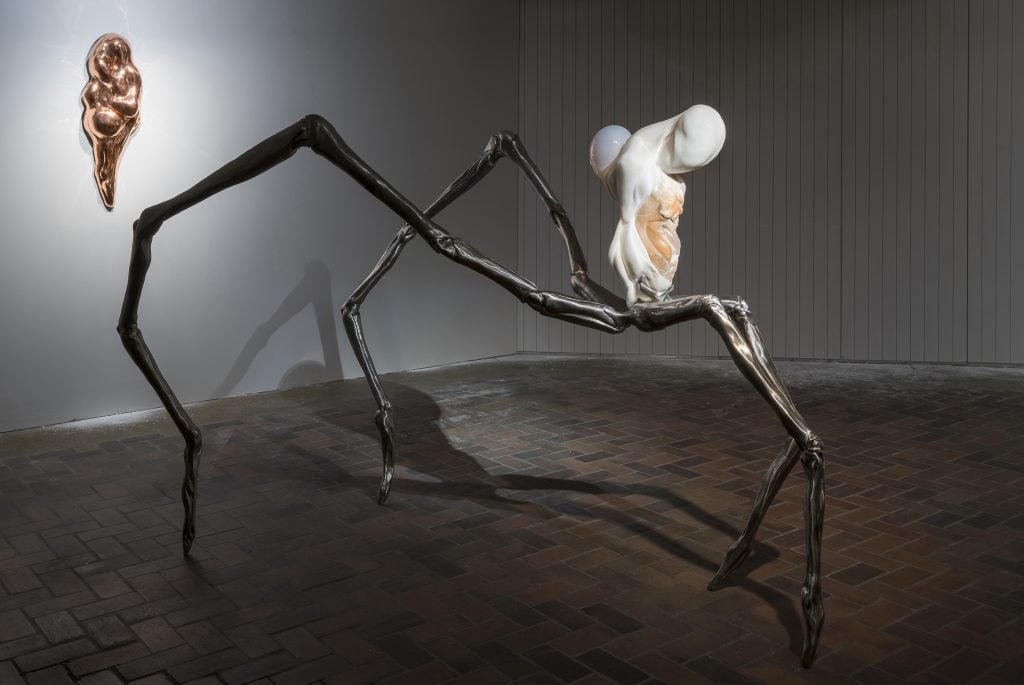
Installation view of “Metempsychosis: The Passion of Pneumatics” (2024), Schinkel Pavillon, Berlin; The exhibition is made possible with the support of Albion Jeune, Balkan Projects, and Francesca Minini. Photograph by Stefan Korte.
How did you go about making something so large and complex in your studio?
The production of this piece was the most challenging process I have ever gone through. The sheer scale of the sculpture, the material and structural complexity, and the amount of challenges I had to overcome for it to be hanging in the space now, is beyond what I could have possibly imagined when I was starting the work four years ago.
Joining all the materials in a structurally sound yet completely seamless way, was so challenging that it made me believe at some point that this piece would never be done. I was working on it full-time for years and often felt like the end was not even on the horizon. I had more breakdowns than I can remember through the process, and in the end, I felt like I was carried by forces larger than myself to complete the work, as I was beyond exhaustion.
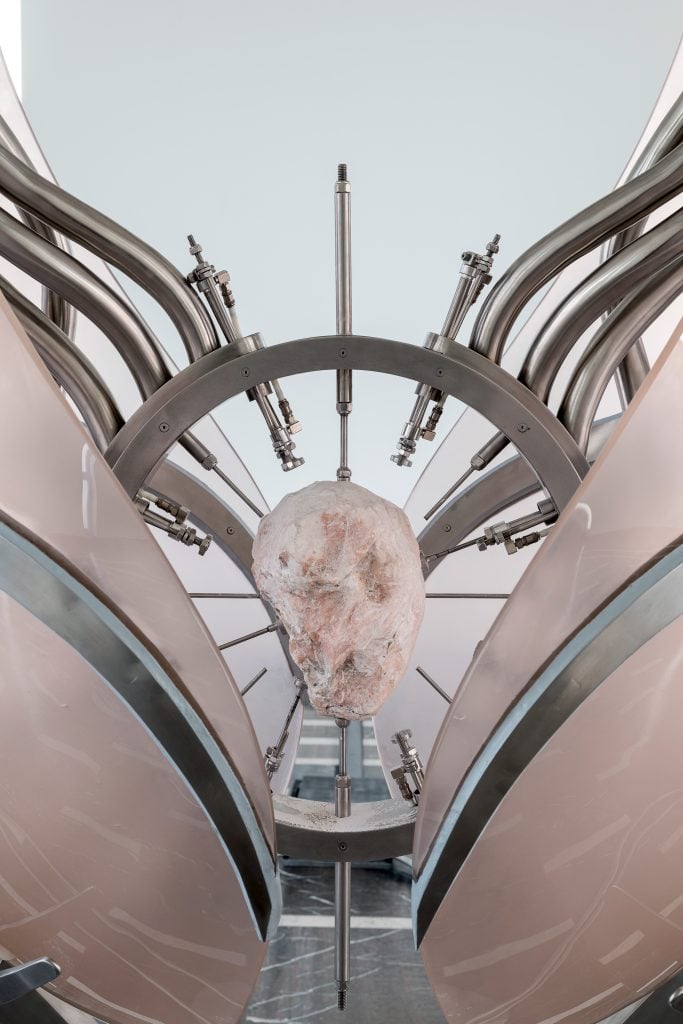
Installation view of “Metempsychosis: The Passion of Pneumatics” (2024), Schinkel Pavillon, Berlin; The exhibition is made possible with the support of Albion Jeune, Balkan Projects, and Francesca Minini. Photograph by Stefan Korte.
Every tiny little part of this fully functional machine is custom-made, thought-out, and designed by myself. The huge glass panels have been custom cast from tiny billets into flat sheets and then slumped over 3D shapes to achieve the kind of curvature I wanted—and then hand-glued by me and my assistants. Components of the machine were made in different workshops in Brooklyn, Chicago, Arkansas, and Oregon before they were assembled in the studio. I was lucky to have the help of great people along the way: a 3D modeler, glass people for both blowing and slumping, help with the pneumatics, CNC, 2D and 3D pipe bending, foundries for metal casting, and so on. Because of the size of the whole installation, I was never able to fully assemble it in my studio as there wasn’t enough space, so for all these years I could only see parts of the final sculpture.
The first time it was fully assembled was during the installation of the show in Schinkel—just a few days before the opening. Seeing it there, as a whole and functioning machine, was an incredible and deeply humbling experience for me. It took all of me to bring this piece into the world.

Installation view of Metempsychosis: The Passion of Pneumatics (2024), Schinkel Pavillon, Berlin; The exhibition is made possible with the support of Albion Jeune, Balkan Projects, and Francesca Minini. Photograph by Stefan Korte.
Your sculptures often bring together contrasting and various materials, from glass to wax and steel. Can you shed light on your sculptural process, from conception to realization?
My sculptures are, surprisingly for some people, neither digitally rendered nor computer-assisted in any way. All of my pieces are painstakingly formed by hand through intricate manual techniques that I have developed over the past decade.
I sculpt my pieces in water-based clay by hand, guided solely by intuition. Oftentimes I don’t even have a drawing. I start from a vague idea of what the piece should feel like when I encounter it but have no idea what it will look like.
The process of sculpting, of finding the forms in clay, can take anywhere from one to 15 months and is a kind of mystical experience that I feel like I have no control over. Often, it feels like a dialogue with invisible forces that are guiding my hand, in order for these beings to appear in clay. And when they do appear, after months and months of sculpting, suddenly there is an acute feeling of the presence in the studio, like I am not alone, and the clay is no longer just a material but is instead inhabited by an entity. This exact feeling is something I keep hearing from my assistants when they come in after the piece has been sculpted—and this is for me one of the most precious experiences in the whole process of making my work. It’s a kind of channeling.
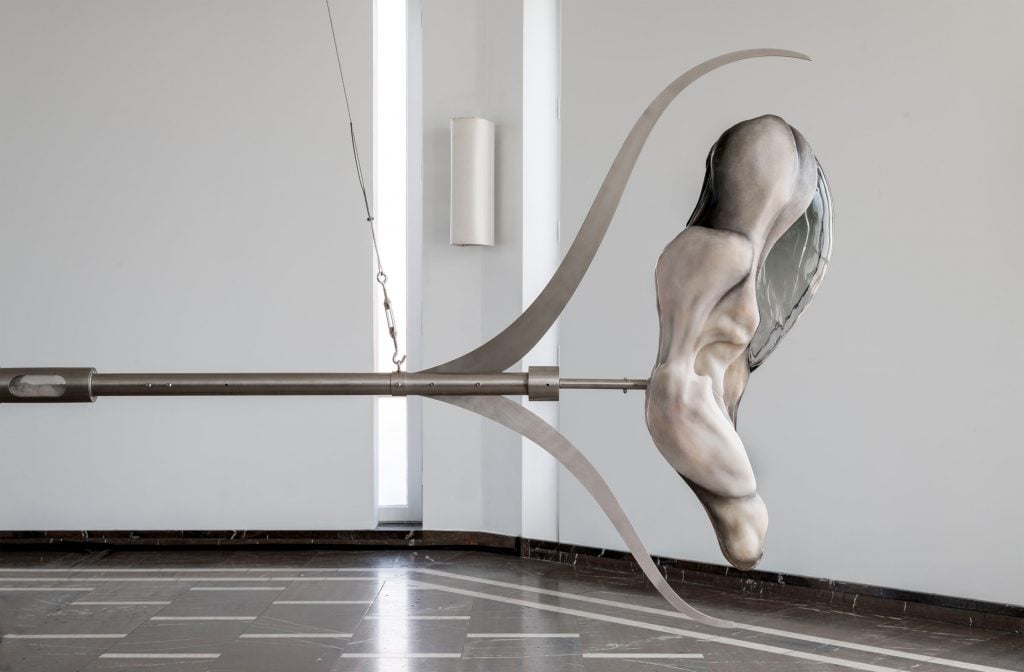
Installation view of “Metempsychosis: The Passion of Pneumatics” (2024), Schinkel Pavillon, Berlin; The exhibition is made possible with the support of Albion Jeune, Balkan Projects, and Francesca Minini. Photograph by Stefan Korte.
Each material is sculpted by hand through a labor-intensive process that includes building armatures; sculpting in clay; mold-making in silicone and Forton; casting wax and bronze elements; fabricating metal components, carving stone, casting Forton positives for glass blowing, making glass blow molds in plaster and silica; blowing glass and cutting it and finally, retrofitting these disparate materials together and painting the pieces in oil paint.
The fact that I make every part of the sculptures myself, is extremely important to me. The negotiation and intimacy with materials allow me to fully imbue the work with what is in me. It allows the work to change and be affected by an intimate process of becoming— rather than being a fixed, cognitive idea merely executed in three dimensions.
The pieces in the exhibition at Schinkel Pavillon in Berlin have been pushed so far that they seem to defy what is materially possible—and this is the longest and slowest part of the process. To go through numerous trials, fail and break pieces, learn from that, and get to know these substances so well as to pressure them to go beyond the limits of what they are capable of becoming—to produce a new kind of materiality. This is one of the things that I am the most proud of. That the work speaks of the transcendence of materiality in a formal, but also very literal way—through the process of its own becoming.
Tell us about your studio more generally.
I have been lucky to be granted a beautiful large sunny studio space on the DUMBO Waterfront as a part of the competitive grant for professional development of artists. The building is luxurious, with a doorman and rooftop garden, and I have been lucky to be in this space for five years now. I have until the end of the year there, so I will be enjoying my last few months there. I am very happy that this challenging and large body of work is finally out of the studio, so I will be scouting for a new space when I am back in New York.
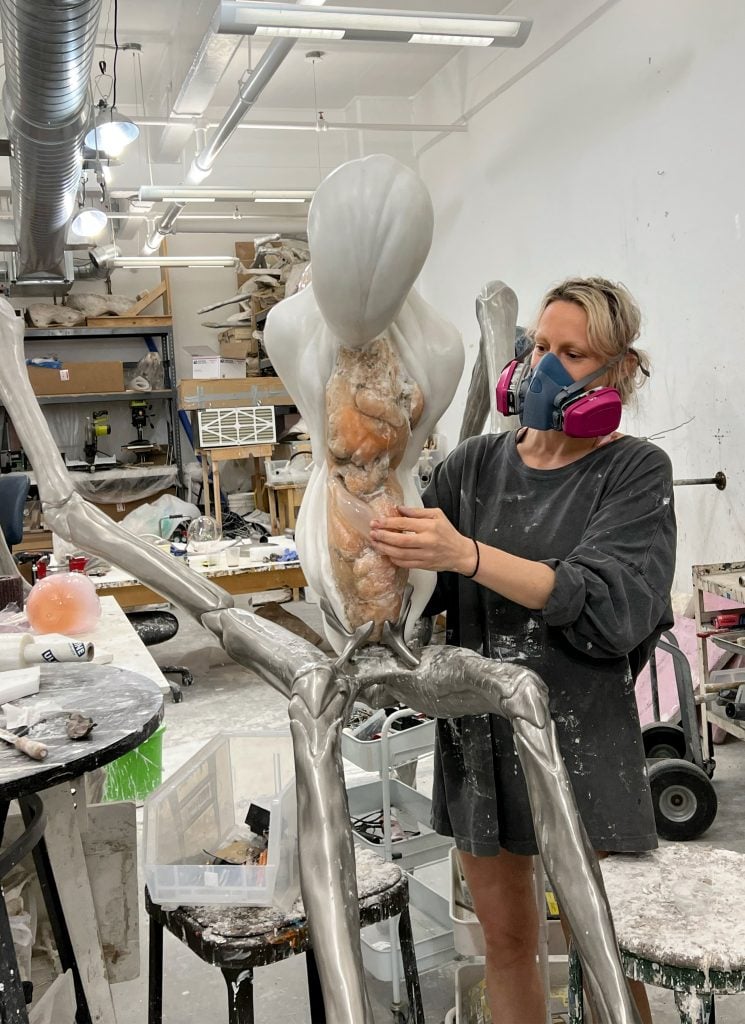
Ivana Bašić in her studio. Photo: Tiffany Nicholson. Image courtesy the artist and Albion Jeune.
What are you working on right now?
I am taking the summer to recover from the long and draining six-year production of the show. I have pieces that have been acquired that I have yet to produce, so I will spend some time working on those when I am back to my studio in mid-August. After that I will go into expanding the universe I built with this Schinkel show, with pieces from the show and their variations. I have been encouraged by the incredibly warm reception that the paintings and drawings received at Schinkel, and I am excited to dive deeper into this part of my practice. The lightness and ease of drawing and painting is an important counter to the heavy material process of my sculpting.
What kind of atmosphere do you prefer when you work?
It is important to me to fully isolate myself from the outside world when I am sculpting, in order to go deep in and access that emotional place from where I make my work. I need to step outside of time and space, however much that is possible, and to do so I work best either late at night or in spaces with no windows where no outside world is visible, where no one is calling on me. I play one composition on a loop every day for the full working day, which is approximately 10 hours, for months at a time. The repeated music blurs time and space in a way that I can detach from them, and exist in a kind of amorphous void.
This feeling of a loop, where the ending and beginning of the sound piece connect into a continuum, offers the kind of stability and neutrality that is necessary for me to work. The process of making the work becomes a meditation, a kind of slow dissolution of the ego, that can allow for something other and bigger than myself to appear. The constantly looping music can be difficult on my studio assistants, who usually end up working with headphones after a few days. The compositions I play are usually either sacred music or pieces from composers like Eliane Radigue or Steve Reich, where the music itself is composed as a repeating loop.
I float in these nebulous, almost formless spaces for long periods, often months at a time, until a figure or piece appears, or until I exhaust that particular emotional space.
When you feel stuck while preparing for a show, what do you do to get unstuck?
This is a difficult one. I have only had this happen once and it was bad. I had a really intense blockage while making one of the sculptures in the Schinkel show. I was sculpting it in clay for 15 months in continuity, full time, and it is not even a very big piece—just about human size. I re-sculpted this piece over 60 times—each time sculpting it into a fully different piece. They were all like half-developed fetuses that could just not be fully formed. I felt like I was somehow unplugged from the channel that allows me to find and make my work, and it was one of the most difficult times I’ve ever had sculpting a piece. Working every day for months on it, with no end in sight, I went through a full breakdown and thought I had lost the ability to make work forever. I stopped assistants from coming into the studio and I sat with the piece alone for about two weeks, not really working on it, just going through an intense internal process of acceptance; accepting whatever it will become, and relinquishing my control over it.
The process escalated into a kind of catharsis that brought me to my most vulnerable state, with a lot of tears and mourning—and during the next two days, after this breakdown, the piece just appeared. When it came, it came so easily, just slipped out of me, almost without me being involved. And what it became is so much more than what I could have inserted into the piece consciously. This blockage was difficult, while I was in it, but it was a very important process to go through, and one I am sure I will encounter again. But hopefully, next time, I will be more prepared.
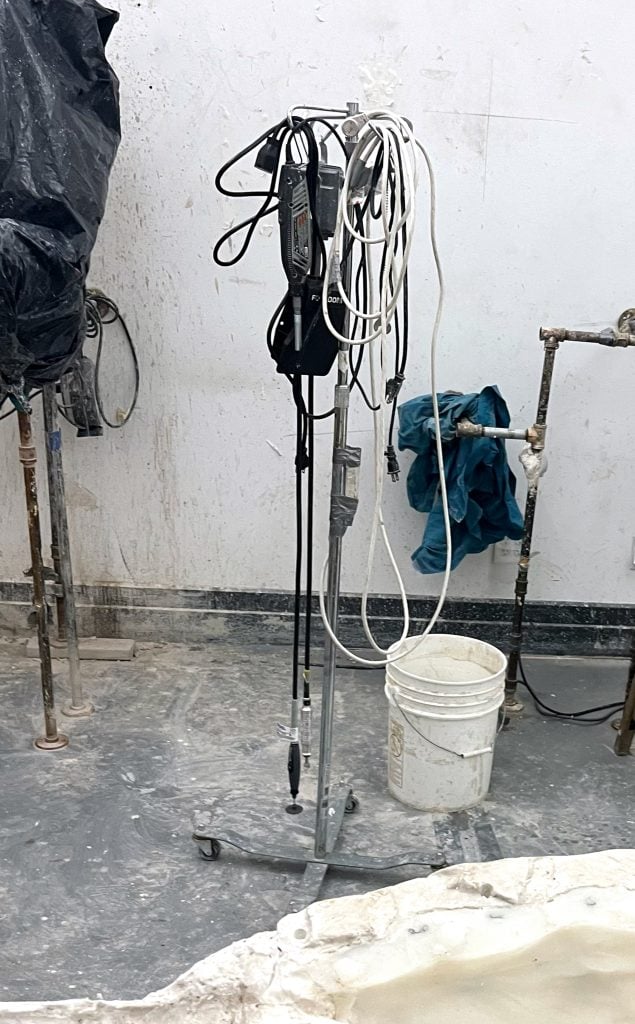
Ivana Bašić’s Dremmel tool in her studio. Photo: Tiffany Nicholson. Image courtesy the artist and Albion Jeune.
What tool or art supply do you enjoy working with the most, and why?
I have one of those medical IV stands with wheels on which I hang three of my Dremel tools and my Foredom flexible shaft, so it’s like a mobile dremmeling station. People always find this use of medical furniture funny. My favorite tools are wooden clay sculpting wire tools. I have so many of them and I keep buying more, each with their special type of wire and size allows for so much maneuvering in the clay. I love it, sculpting in water-based clay was love at first touch for me and I really indulge in the malleability, softness, and smell of clay when I am in that process. I feel like my unconscious just seeps out of my hands into the clay—it feels like magic.
Metempsychosis: The Passion of Pneumatics is on view at Schinkel Pavillon until September 1